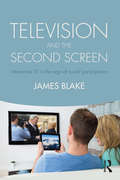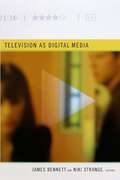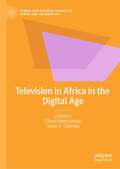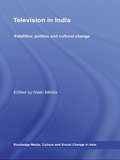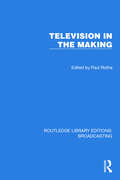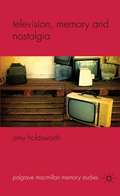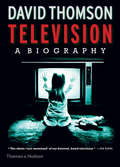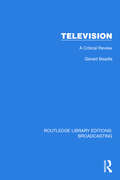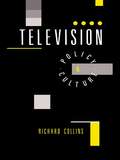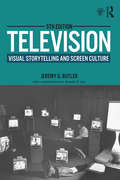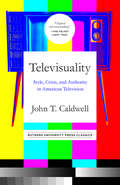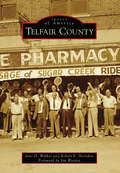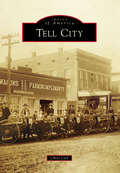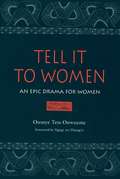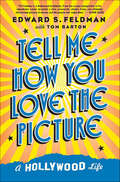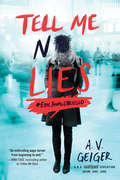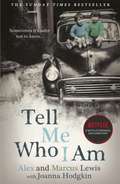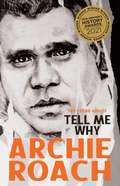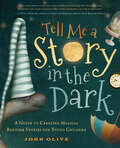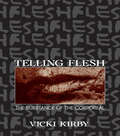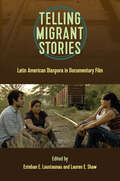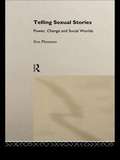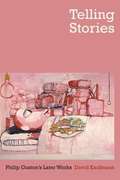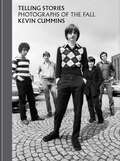- Table View
- List View
Television and the Second Screen: Interactive TV in the age of social participation
by James BlakeTelevision is changing almost beyond recognition. In the battle for consumers, social media sites, smart phones and tablets have become rivals to traditional linear TV. However, audiences and producers are also embracing mobile platforms to enhance TV viewing itself. This book examines the emerging phenomenon of the second screen: where users are increasingly engaging with content on two screens concurrently. The practice is transforming television into an interactive, participatory and social experience. James Blake examines interactive television from three crucial angles: audience motivation and agency, advances in TV production and the monetisation of second screen content. He also tracks its evolution by bringing together interviews with more than 25 television industry professionals - across the major UK channels - including commissioning editors, digital directors, producers and advertising executives. These reveal the successes and failures of recent experiments and the innovations in second screen projects. As the second screen becomes second nature for viewers and producers, the risks and opportunities for the future of television are slowly beginning to emerge. Television and the Second Screen will offer students and scholars of television theory, industry professionals and anyone with an abiding interest in television and technology, an accessible and illuminating guide to this important cultural shift.
Television as Digital Media
by James Bennett Niki StrangeIn Television as Digital Media, scholars from Australia, the United Kingdom, and the United States combine television studies with new media studies to analyze digital TV as part of digital culture. Taking into account technologies, industries, economies, aesthetics, and various production, user, and audience practices, the contributors develop a new critical paradigm for thinking about television, and the future of television studies, in the digital era. The collection brings together established and emerging scholars, producing an intergenerational dialogue that will be useful for anyone seeking to understand the relationship between television and digital media. Introducing the collection, James Bennett explains how television as digital media is a non-site-specific, hybrid cultural and technological form that spreads across platforms such as mobile phones, games consoles, iPods, and online video services, including YouTube, Hulu and the BBC's iPlayer. Television as digital media threatens to upset assumptions about television as a mass medium that has helped define the social collective experience, the organization of everyday life, and forms of sociality. As often as we are promised the convenience of the television experience "anytime, anywhere," we are invited to participate in communities, share television moments, and watch events live. The essays in this collection demonstrate the historical, production, aesthetic, and audience changes and continuities that underpin the emerging meaning of television as digital media. Contributors. James Bennett, William Boddy, Jean Burgess, John Caldwell, Daniel Chamberlain, Max Dawson, Jason Jacobs, Karen Lury, Roberta Pearson, Jeanette Steemers, Niki Strange, Julian Thomas, Graeme Turner
Television in Africa in the Digital Age (Gender and Cultural Studies in Africa and the Diaspora)
by Gilbert Motsaathebe Sarah H. ChiumbuThis book places television in Africa in the digital context. It address the onslaught of multimedia platforms, digital migration and implication of this technology for society. The discussions in the chapters contained in this book encompass a wide range of issues such as digital disruption of television news, internet television and video on demand platforms, adaptations, digital migration, business strategies and management approaches, PBS, consumption patterns, scheduling and programming, evangelical television, and many others. The book is an important reading for academics, students and television practitioners. It offers an insightful view of television in Africa.
Television in India: Satellites, Politics and Cultural Change (Media, Culture and Social Change in Asia)
by Nalin MehtaThis book examines the development of television in India since the early 1990s, and its implications for Indian society more widely. Until 1991, India possessed only a single state-owned television channel, but since then there has been a rapid expansion in independent satellite channels which came as a complete break from the statist control of the past. This book explores this transformation, explaining how television, a medium that developed in the industrial West, was adapted to suit Indian conditions, and in turn has altered Indian social practices, making possible new ways of imagining identities, conducting politics and engaging with the state. In particular, satellite television initially came to India as the representative of global capitalism but it was appropriated by Indian entrepreneurs and producers who Indianized it. Considering the full gamut of Indian television - from "national" networks in English and Hindi to the state of regional language networks – this book elucidates the transformative impact of television on a range of important social practices, including politics and democracy, sport and identity formation, cinema and popular culture. Overall, it shows how the story of television in India is also the story of India's encounter with the forces of globalisation.
Television in Turkey: Local Production, Transnational Expansion and Political Aspirations
by Yeşim Kaptan Ece AlganThis edited collection takes a timely and comprehensive approach to understanding Turkey’s television, which has become a global growth industry in the last decade, by reconsidering its geopolitics within both national and transnational contexts. The Turkish television industry along with audiences and content are contextualised within the socio-cultural and historical developments of global neoliberalism, transnational flows, the rise of authoritarianism, nationalism, and Islamism. Moving away from Anglo-American perspectives, the book analyzes both local and global processes of television production and consumption while taking into consideration the dynamics distinctive to Turkey, such as ethnic and gender identity politics, media policies and regulations, and rising nationalistic sentiments.
Television in the Making (Routledge Library Editions: Broadcasting #37)
by Paul RothaTelevision in the Making (1956) looks at television in its infancy, with essays by the leaders of the medium at the time, people who were forging new paths as they imagined and actioned the possibilities of television.
Television, Memory and Nostalgia
by Amy HoldsworthAn innovative and original new study, Television, Memory and Nostalgia re-imagines the relationship between the medium and its forms of memory and remembrance through a series of case studies of British and North American programmes and practices. These include ER , Grey's Anatomy , The Wire , Who Do You Think You Are? , and Life on Mars .
Television: A Biography
by David Thomson“The invention, or the quaint piece of furniture, wandered into our lives in the 1940s, as a primitive plaything, a clever if awkward addition to the household. It was expensive, unreliable and a bit of an invalid.” —Television, A Biography In just a few years, what used to be an immobile piece of living room furniture, which one had to sit in front of at appointed times in order to watch sponsored programming on a finite number of channels, morphed into a glowing cloud of screens with access to a near-endless supply of content available when and how viewers want it. With this phenomenon now a common cultural theme, a writer of David Thomson’s stature delivering a critical history, or “biography” of the six-decade television era, will be a significant event which could not be more timely. With Television, the critic and film historian who wrote what Sight and Sound's readers called “the most important film book of the last 50 years” has finally turned his unique powers of observation to the medium that has swallowed film whole. Over twenty-two thematically organized chapters, Thomson brings his provocatively insightful and unique voice to the life of what was television. David Thomson surveying a Boschian landscape, illuminated by that singular glow—always “on”—and peopled by everyone from Donna Reed to Dennis Potter, will be the first complete history of the defining medium of our time.
Television: A Critical Review (Routledge Library Editions: Broadcasting #35)
by Gerald BeadleTelevision: A Critical Review (1963) is written by Sir Gerald Beadle, once Director of the BBC, and possessing of a long and wide experience of broadcasting as it expanded and grew. He was there at the birth of television, and details this and the subsequent developments over many years into a global phenomenon.
Television: Policy and Culture
by Richard CollinsIn this important and wide-ranging text, Richard Collins combines original research with provocative analysis and argument. He focuses on the impact of new television technologies, national policies for television for television in North America and Europe, the effects of internationalisation, television news and documentaries and the history and likely development of media studies.
Television: Visual Storytelling and Screen Culture (Routledge Communication Ser.)
by Jeremy G. ButlerFor over two decades, Television has served as the foremost guide to television studies, offering readers an in-depth understanding of how television programs and commercials are made and how they function as producers of meaning. Author Jeremy G. Butler shows the ways in which camera style, lighting, set design, editing, and sound combine to produce meanings that viewers take away from their television experience. Highlights of the fifth edition include: An entirely new chapter by Amanda D. Lotz on television in the contemporary digital media environment. Discussions integrated throughout on the latest developments in screen culture during the on-demand era—including the impact of binge-watching and the proliferation of screens (smartphones, tablets, computer monitors, etc.). Updates on the effects of new digital technologies on TV style.
Televisuality: Style, Crisis, and Authority in American Television (Communications, Media, and Culture Series)
by John T CaldwellAlthough the "decline" of network television in the face of cable programming was an institutional crisis of television history, John Caldwell's classic volume Televisuality reveals that this decline spawned a flurry of new production initiatives to reassert network authority. Television in the 1980s hyped an extensive array of exhibitionist practices to raise the prime-time marquee above the multi-channel flow. Televisuality demonstrates the cultural logic of stylistic exhibitionism in everything from prestige series (Northern Exposure) and "loss-leader" event-status programming (War and Remembrance) to lower "trash" and "tabloid" forms (Pee-Wee's Playhouse and reality TV). Caldwell shows how "import-auteurs" like Oliver Stone and David Lynch were stylized for prime time as videographics packaged and tamed crisis news coverage. By drawing on production experience and critical and cultural analysis, and by tying technologies to aesthetics and ideology, Televisuality is a powerful call for desegregation of theory and practice in media scholarship and an end to the willful blindness of "high theory."
Telfair County
by Jim Wooten Jane H. Walker Robert E. HerndonCreek Indians inhabited land that was to become Telfair County. The early population was made up of settlers of Scottish descent. They had to produce almost everything they used, from food to equipment. Named for Edward Telfair, a two-term governor of Georgia, the county was formed in 1807 from a portion of Wilkinson County. Gradually, several counties were formed from parts of Telfair. Since 1870, Telfair County has kept its current boundaries. The original county seat was located in Jacksonville, about 20 miles south of McRae, Georgia, where it was moved by the legislature in 1871. While Georgia was a hotbed of secession, Telfair County representatives to the Secession Convention in 1861 voted "no" to the resolution, reflecting the sentiment of the county's population. Even though there was strong objection to secession, many Telfair County citizens did their duty and volunteered to serve the Southern cause.
Tell City (Images of America)
by Chris CailFounded in 1858, Tell City is located in the rolling hills of southern Indiana, along the Ohio River between Evansville, Indiana, and Louisville, Kentucky. Carefully planned by the Swiss Colonization Society of Cincinnati, Ohio, Tell City was originally named Helvetia. To proclaim their Swiss origin and honor their hero, William Tell, the founders chose to rename the area Tell City. Tell City is known for its famous Tell City Pretzels, a tradition that dates back to 1858, and the Tell City Chair Company, a well-known manufacturer of Early American–style furniture. After the closing of the Tell City Chair Company, the city changed from a furniture-manufacturing community to a more automotive-manufacturing community, with Waupaca and ATTC Manufacturing both employing a total of 1,500 people.
Tell It to Women: An Epic Drama for Women
by Ngugi Wa Thiong’o Osonye Tess OnwuemeUsing the magic of movement, dance, and drama, and the devices of humor and metaphor, Osonye Tess Onwueme has created a post-feminist epic drama that transcends current feminist theories. An ideologically and politically powerful work, Tell It to Women offers a critical discourse on the western feminist movement from an African traditional perspective, focusing attention on the often silenced issues of intra-gender politics and class inequities.
Tell Me How You Love the Picture: A Hollywood Life
by Edward S. Feldman Tom BartonEdward S. Feldman's legendary career began in advertising and publicity at 20th Century-Fox in the 1950s, and from there he worked his way up to executive studio positions within Seven Arts, Filmways, and Warner Brothers. Following this, he has spent the last twenty-five years as a successful, Academy Award-nominated film producer.Ed's unique story takes readers on a more than fifty-year journey through Hollywood that few can tell--and most will never forget. With tales from the set of Whatever Happened to Baby Jane? to why a well-known actor trashed Ed's office and why a major Hollywood mogul tried to turn all of Tinseltown against one of Ed's films, readers will learn what it takes to produce a film and survive the jungles of Hollywood, laughing all the way.Tell Me How You Love the Picture is a smartly written, surprising, hilarious memoir that takes us behind the scenes with wild, no-holds-barred stories about major Hollywood personalities ranging from Bette Davis to Elizabeth Taylor, Stanley Kubrick to Scott Rudin, Harrison Ford to Jim Carrey to Eddie Murphy and more. As a top studio exec and one of Hollywood's most respected producers, Feldman has seen the film business from the inside out, worked with some of the best talent in the industry, and experienced things few can imagine.An incredible Hollywood memoir from one of moviedom's renowned producers, Tell Me How You Love the Picture is full of insight and the stuff of gossip, bad behavior, and high success.
Tell Me No Lies (Follow Me Back #2)
by A. V. GeigerRealEricThorn No one knows what happened to pop icon Eric Thorn. His Twitter account? Frozen. His cell phone? Cracked and bloody, buried in the snow. Snowflake734Tessa Hart knows the truth, but she's finally left her #EricThornObsessed days behind. She has no intention of ever touching her Twitter app again. But SnapChat...That's safer, right? Agoraphobic fangirl Tessa Hart has finally left her house—only to trade one hiding place for another. But she can only stay out of sight for so long before she's forced to face the deadly consequences of the past. Back in an interrogation room, answers only lead to more questions in the pulse-pounding conclusion to the Follow Me Back duology.
Tell Me Who I Am: The Story Behind the Netflix Documentary
by Joanna Hodgkin Alex And Marcus LewisThe story behind the hit Netflix documentary: The bestselling account of the bond between brothers and the shocking legacy of a dangerous mother.Imagine waking up one day to discover that you have forgotten everything about your life. Your only link with the past, your only hope for the future, is your identical twin.Now imagine, years later, discovering that your twin had not told you the whole truth about your childhood, your family, and the forces that had shaped you. Why the secrets? Why the silences? You have no choice but to begin again.This has been Alex's reality: a world where memories are just the stories people tell you, where fact and fiction are impossible to distinguish. With dogged courage he has spent years hunting for the truth about his hidden past and his remarkable family. His quest to understand his true identity has revealed shocking betrayals and a secret tragedy, extraordinary triumph over crippling adversity and, above all, redemption founded on brotherly love.Marcus his twin brother has sometimes been a reluctant companion on this journey, but for him too it has led to staggering revelations and ultimately the shedding of impossible burdens. Their story spans continents and eras, from 1950s debutantes and high society in the Home Counties to a remote island in the Pacific and 90s raves. Disturbing, funny, heart-breaking and affirming, Alex and Marcus's determination to rebuild their lives makes us look afresh at how we choose to tell our stories.
Tell Me Why for Young Adults
by Archie Roach&‘There are many Australian stories, and mine is just one about what happened to me and other First Peoples of this country. It&’s important for me to tell my story – because it&’s not just part of my healing but of this country&’s as well. We all have a story and as you read this book I would like you to think of your own story, what that means and who is also a part of your story.&’ In his inspirational, highly acclaimed memoir – and including reflections from First Nations Elders and young people – Archie Roach tells the story of his life and his music. Only two when he was forcibly removed from his family, and brought up by a series of foster parents until his early teens, Archie&’s world imploded when he received a letter that spoke of a life he had no memory of. It took him almost a lifetime to find out who he really was. Tell Me Why is an unforgettable story of resilience, strength of spirit and hope.
Tell Me a Story in the Dark: A Guide to Creating Magical Bedtime Stories for Young Children
by John OliveTonight, don't read your child a story. Instead, dim the light, lie down, and create storytelling magic. Weave a spell that will enchant your child. . .Written by an award-winning playwright, Tell Me A Story In The Dark provides you with every tool you need to tell great and entertaining stories. In a day when parents want to spend more quality time with their children, Tell Me A Story In The Dark:Shows you how to prepare and tell a story.Communicates the enormous benefits—ending the bedtime battle of wills, building vocabulary, making room for effective parenting moments.Provides a treasure trove of stories that parents (and grandparents) can adapt for their children.Teaches you how to make up and tell your own stories.Anyone who loves children will love this book.
Telling Flesh: The Substance of the Corporeal
by Vicki KirbyFirst Published in 1997. Routledge is an imprint of Taylor & Francis, an informa company.
Telling Migrant Stories: Latin American Diaspora in Documentary Film (Reframing Media, Technology, and Culture)
by Esteban E. Loustaunau and Lauren E. ShawIn the media, migrants are often portrayed as criminals; they are frequently dehumanized, marginalized, and unable to share their experiences. Telling Migrant Stories explores how contemporary documentary film gives voice to Latin American immigrants whose stories would not otherwise be heard.The essays in the first part of the volume consider the documentary as a medium for Latin American immigrants to share their thoughts and experiences on migration, border crossings, displacement, and identity. Contributors analyze films including Harvest of Empire, Sin país, The Vigil, De nadie, Operation Peter Pan: Flying Back to Cuba, Abuelos, La Churona, and Which Way Home, as well as internet documentaries distributed via platforms such as Vimeo and YouTube. They examine the ways these films highlight the individual agency of immigrants as well as the global systemic conditions that lead to mass migrations from Latin American countries to the United States and Europe.The second part of the volume features transcribed interviews with documentary filmmakers, including Luis Argueta, Jenny Alexander, Tin Dirdamal, Heidi Hassan, and María Cristina Carrillo Espinosa. They discuss the issues surrounding migration, challenges they faced in the filmmaking process, the impact their films have had, and their opinions on documentary film as a force of social change. They emphasize that because the genre is grounded in fact rather than fiction, it has the ability to profoundly impact audiences in a way narrative films cannot. Documentaries prompt viewers to recognize the many worlds migrants depart from, to become immersed in the struggles portrayed, and to consider the stories of immigrants with compassion and solidarity. Contributors: Ramón Guerra | Lizardo Herrera | Jared List | Esteban Loustaunau | Manuel F. Medina | Ada Ortúzar-Young | Thomas Piñeros Shields | Juan G. Ramos | Lauren Shaw | Zaira Zarza A volume in the series Reframing Media, Technology, and Culture in Latin/o America, edited by Héctor Fernández L'Hoeste and Juan Carlos Rodríguez
Telling Sexual Stories: Power, Change, And Social Worlds
by Ken PlummerThis book explores the rites of a sexual story-telling culture. Taking three major examples - rape stories, coming-out stories, recovery stories - it examines the nature of these newly emerging narratives and the socio-historical conditions which have given rise to them. It looks at the rise of the women's movement, the lesbian and gay movement and the 'recovery' movement as harbingers of significant social change that encourage the telling of new stories.
Telling Stories: Philip Guston's Later Works
by David KaufmannGuston was best known for abstract work and cartoons. In this book, the author follows the development of his painting from the early 1960s until the artist's death in 1980 and explores his intense and complicated relationship to Judaism.
Telling Stories: Photographs of The Fall
by Kevin Cummins'No one has captured the look of alternative UK music over the past half a century more tellingly than Kevin Cummins.' - Simon Armitage'Kevin Cummins is a true master in being able to capture the essence of music, the soul of the band. Whatever he does however he does it is a mystery to me but it's pure genius.' - Rankin'Few photographers had such a close connection to The Fall as Manchester-based Kevin Cummins, and his new book, Telling Stories, is a rich visual history of one of the city's most beloved and enduring bands.' - Record Collector Magazine 'Kevin has the uncanny ability of capturing the inner mood of musicians. Be it the dynamics within a pensive Joy Division, or the sense surrounding the fledgeling Fall that something special was around the corner for us all. Kevin's book is nothing less than a remarkable document of a bewildering and defiant anti-fashion movement born in Prestwich, north Manchester in the grimy mid-70s.' - Marc Riley'Capturing forty years of the band's career via his archive, the legendary photographer (whose recent book, Juvenes, documented the story of Joy Division) gives his take on the phenomenon of The Fall and the late, great Mark E. Smith.' - Vive le Rock Contains never-before-seen images.Foreword by Simon Armitage, Poet Laureate. From chaotic early gigs to their final years, NME photographer Kevin Cummins provides a definitive, unique perspective on cult favourites The Fall. In this stunning visual history spanning four decades, discover how and why they emerged as one of the most innovative, boundary-breaking bands in modern music.With a foreword by Poet Laureate and Fall fan Simon Armitage and an interview with Eleni Poulou, as well as never-before-seen images from Cummins' archive, this is the ultimate visual companion to The Fall.
